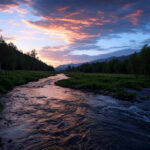Tucked along the edge of the frigid James Bay, Moosonee stands as one of Northern Ontario’s most remote and storied communities—a place often referred to as the “Gateway to the Arctic.” While towns like Thunder Bay or Rainy River echo similar titles, Moosonee carries its own unique distinctions.
This isolated town of about 3,000 people is shaped by its subarctic climate, deep cultural roots, and resilient spirit. Roughly 85 percent of Moosonee’s population identifies as Cree, forming a monogamous and close-knit community that has thrived for generations despite limited access to year-round infrastructure and health care services.
For elderly Indigenous individuals who thrive in connection to their environment, community paramedicine is an opportunity to reimagine health care and make these people feel like they truly belong.
The health struggles of elderly Indigenous individuals
Much of the historical barriers and trauma from residential schools and systemic violence still affect mental well-being, especially among the elderly. Ongoing racism, underfunded care, and a lack of cultural safety undermine trust and access. What we see is a vast disconnect between Western health and the Indigenous people’s more holistic practices and spiritual connection to the land.
Many of the Indigenous elderly are pressured to leave their home, to move to more urban cities where they are unfamiliar with their surroundings, simply to get access to the medical care they need. These people tend to be poorer, have more experience with food insecurity, and face more chronic health problems (such as high blood pressure, arthritis, heart disease, diabetes, and depression) than non-Indigenous seniors.
What does this mean for seniors who’ve refused to move? The near impossibility of receiving prompt care for chronic conditions, such as heart disease. Regarding Moosonee, a ScienceDirect article details that some individuals had to travel up to nine hours for specialized cardiovascular care.
Disparities in fundamental human rights have resulted in institutions, like WAHA, being flooded with thousands of calls from older Indigenous peoples.
Noah Weinberg is an advocate for alternative response programs.














![Rebuilding the backbone of health care [PODCAST]](https://kevinmd.com/wp-content/uploads/Design-3-190x100.jpg)


![Reimagining medical education for the 21st century [PODCAST]](https://kevinmd.com/wp-content/uploads/Design-1-190x100.jpg)


![A question about maternal health and the rise in autism [PODCAST]](https://kevinmd.com/wp-content/uploads/Design-4-190x100.jpg)
